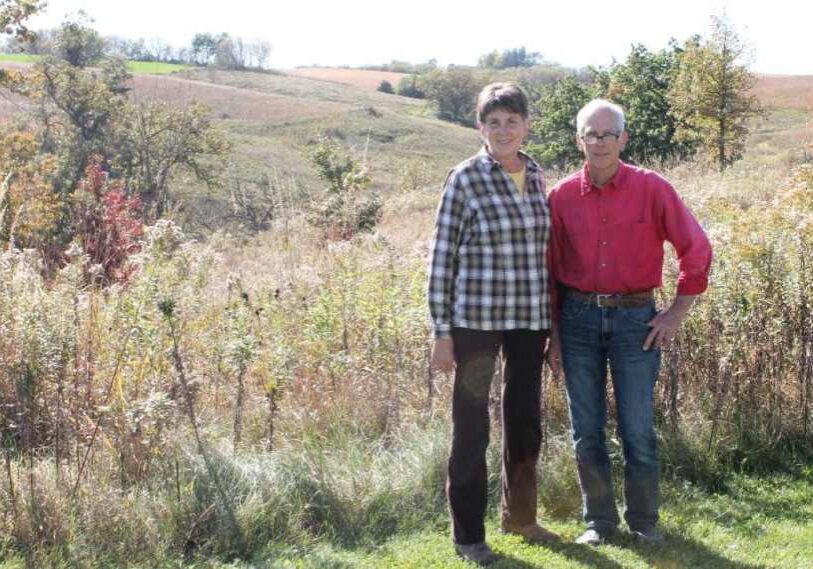Longest-Running Community Science Bird Project Celebrates 125 Years

WINONA COUNTY — It was New Year’s Day, 2025, and Jeremy Darst called his team around him for a pre-event pep talk.
Take your time, run your routes just as I showed you, he said. Stay with the play book. You’re not professionals but what you’re going to do in the next four hours or more has to be done right. After all, the birds depend on you, said the head naturalist at Whitewater State Park south of Elba, Minn.

A female cardinal and a bluejay rest in the brush. (Photo by John Weiss)
The event was the annual Christmas Bird Count in and around the park that is part of the nation’s longest-running community science bird project (held each year between December 14 and January 5). It was started in 1900 by people appalled at a tradition of others going out on Christmas to shoot as many birds as they could in “side hunts.”

Sparrows and finches perch in branches during the Great Christmas Bird Count at Whitewater State Park. (Photo by John Weiss)
Critical scientific work made fun
Instead of shooting birds, let’s count them, bird lovers decided. It began small, as many such events do. But in 2024, according to Audubon, there were 2,677 counts from Canada, throughout the United States into the Caribbean and even the Pacific Islands. A record 83,186 people, nearly all amateurs, identified 40,871,030 birds, 2,380 species in all. Most went out to count, some stayed by bird feeders (their data are kept separately).
In Minnesota, 2,251 birders took part, identifying 375,786 birds, 30 percent higher than the year before.
The annual count, however, is much more than a fun time for birders. Data gathered are critical which is why Darst, who was coach/coordinator, stressed that only birds that can be positively identified can be counted.

Two bald eagles circle near Utica in Winona County, Minnesota. (Photo by John Weiss)
“Audubon uses the numbers from the Christmas bird count in a lot of their data compiling and research,” he said. “This is a very valuable data set.” Birds are great indicators of climate change, and how well their habitat is doing.
“The impact goes beyond just numbers,” according to the U.S. Fish and Wildlife Service. “Christmas Bird Count data helps us better understand birds so we can better protect them!”
New friends, warm clothes and hot coffee fuel the search
Finally, Darst told about two dozen birders, “take your time, don’t be in a rush. Grab a cup of coffee, grab a muffin, grab a croissant and thank you for coming out to do this.”
With that, birders broke up into groups covering six areas in and Whitewater State Park.

A trio of birders walks a gravel road, hoping to see more birds. (Photo by John Weiss)
One group included Dave Nelson of Rochester. He said he’s a relative newbie but still takes part. “I do it because it’s fun, too,” he said. “I enjoy the company, the chase, just trying to find something new.” It’s a chance to add to his list of birds he’s seen.
With him was Jerry Pruett of Rochester, one of the best birders in the region and state. He’s been on countless counts of all kinds but still, he came. “It’s fun,” he said. “I do it because it’s fun.”

Jerry Pruett looks over the daily tally sheet with Dave Nelson. (Photo by John Weiss)
I joined another group, all four of us relative amateurs.
Dave Ogren, of Winona, said he’s always been interested in birding and after moving to Winona from the Twin Cities he decided to go on this count, his third one. “I would like to be (a big-time birder) so I’ve always had an interest in birds,” he said. “I have not spent a lot of time pursuing it. This is an effort to do that.”

Dave Ogren kept his bird book in his back pocket but said his fingers were too cold to use it. (Photo by John Weiss)
Ruth Liew of Harmony had never birded before and came with her friend Alan Hockersmith of Mabel. “I’m out here for a good time in nature,” she said. Sure, they are a few out of the tens of thousands, but “we are the only people counting this area.”

Alan Hockersmith checks tree tops while holding the tally sheet. (Photo by John Weiss)
Hockersmith said he’s heard about the count “and I wanted to see what it was about. Management and stewardship of nature is important. If we’re going to look at the earth as just part of the earth and we don’t mind using the earth . . . we need to manage and be stewards of it.”
With that, the four of us drove to the South Branch of the Whitewater River, got out and started.
I immediately tallied a bald eagle and heard a woodpecker, almost certainly a hairy or downy. “Almost” wasn’t enough. The others saw a few black-capped chickadees and, of course, crows. But with the cold, wind and overcast, we didn’t see many birds – maybe they were just hanging low. “I don’t hear a thing, I don’t see a thing,” Ogren said.
With that, we drove above the bluff to a parking lot that’s part of the Whitewater Wildlife Management Area. Again, we walked slowly and added a cardinal and a few other birds.

A male cardinal feeds on the ground at Whitewater State Park. (Photo by John Weiss)
Hockersmith saw a bird and “it kind of flies like a chickadee but I didn’t see it very well.” It wasn’t entered. “I have my bird book but my fingers are too cold to look at it,” Ogren said.
We drove some more and the trio in the car behind me saw eight robins I missed. Coming into Utica, we counted four more bald eagles.
Then we went back to the South Branch farther from where we had been first.
“I can’t believe how few birds,” Ogren said. Not even the usually numerous chickadees and nuthatches. “I think the last two years there were many times more birds than we are seeing this year.” But conditions were better with snow in the past few years and that makes birds easier to see.
With a few more crows, we were done and drove back to the park. “The crows won the day with 14; followed by black-capped chickadees and bald eagles at 11 each,” Hockersmith said. “We saw eight robins, five bluejays, two nuthatches, two cardinals, and a couple woodpeckers.”
Coming in after us was Mike Degerstrom of Rochester who tallied for his group. They did better with Eurasian collared doves, finches, chickadees and a pheasant. Snow would have been nice, he said, so they might have seen horned larks, snow buntings and Hungarian partridge.

Tom Sobeck finishes paperwork while his wife, Kelly, chats with others. (Photo by John Weiss)
Tom and Kelly Sobeck of Rochester, who volunteered for their fifth time, said they fared better than last year with a bald eagle, chickadees, two pileated woodpeckers, as well as downy and hairy woodpeckers and a kestrel. They birded around Carley State Park. “It’s a great way to start out a new year,” Kelly Sobeck said.
Nelson was also satisfied with his group’s total of 24 species including a golden eagle, merlin and a yellow-bellied sapsucker that is rarer.
Darst wasn’t surprised at the varying results. “It’s like fishing,” he said “It’s not guaranteed to catch fish and it’s not guaranteed to see birds. You have to take the value of getting out and experiencing it” along with the value of the data.
When he did a preliminary count, he said the 23 people saw 1,163 birds and spent an average 4.5 hours out. “These 5 species had the highest number of reported sightings during the count: American crows, rock pigeons, European starlings, house sparrows and dark-eyed juncos.
Your turn to count
Birders of all ages and abilities have another chance to help count and add data right from the comfort of home.
From February 14 through 17, 2025 Audubon hosts another worldwide bird count called the Great Backyard Bird Count. Its website offers great bird identification tools and simple instructions on how to participate.






